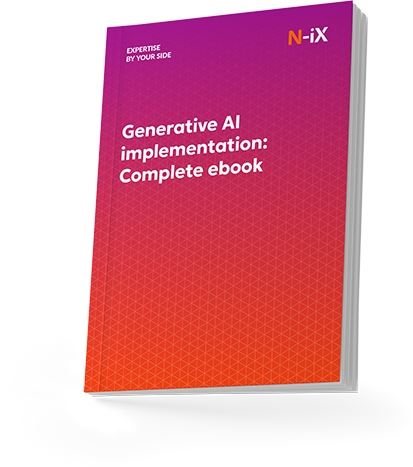The 2025 State of AI report by McKinsey surveyed companies worldwide to explore the usage, implementation, and challenges of AI. According to the report, 71% of respondents confirmed that their organizations frequently use generative AI in at least one business function, up from 65% in early 2024. However, the widespread use of GenAI also comes with emerging security concerns, which can lead to data leaks, cyberattacks, and reputational damage.
What are the main generative AI security risks, and how to mitigate them? We consulted our cybersecurity experts to provide insights to help you protect your AI initiatives.
The main security risks of generative AI
Understanding generative AI security risks is crucial to developing effective protection strategies. Let's review the main issues related to GenAI:
Data privacy and leakage
Generative AI systems typically require large-scale datasets for training, which may include private or sensitive information. If data isn't properly anonymized, the AI could generate outputs that expose private details. For example, chatbots might "memorize" and leak medical records or financial data, resulting in significant AI privacy concerns. This also raises compliance issues with regulations like GDPR or ISO/IEC 42001, emphasizing the need for robust data governance.
Your full guide to generative AI implementation—get the 5-step roadmap!


Success!

Deepfakes and misinformation
GenAI can create hyper-realistic synthetic media, including fake videos, audio, and text. Malicious actors exploit this to spread disinformation, manipulate public opinion, or impersonate individuals for fraud. Deepfakes can significantly erode trust and pose privacy threats.
Hallucinations
GenAI models generate information that appears credible and authoritative but is entirely fabricated or factually incorrect. Unlike obvious errors, hallucinations are particularly dangerous because they are often presented with the same confidence and formatting as accurate information, making them difficult to detect without careful verification.
Model and data poisoning
Malicious actors can tamper with training data or manipulate AI models to produce biased or harmful results. An example is injecting toxic content into datasets, causing the AI to generate offensive or misleading outputs. Such attacks compromise the reliability and integrity of AI systems.
Prompts injection
Attackers can also manipulate the input prompts given to AI models to bypass safety measures, extract sensitive information, or cause the system to behave in unintended ways. They exploit the way AI models process and respond to user inputs.
Ethical and legal risks
The deployment of generative AI may trigger moral concerns, particularly when algorithms reproduce discriminatory patterns found in their source data. Legally, using copyrighted material without permission for training poses infringement risks, while accountability remains unclear when AI-generated content causes harm, creating complex liability issues.
Phishing attacks and malware
Attackers can exploit AI to create persuasive phishing emails or targeted social engineering content, significantly enhancing the effectiveness of attacks. Additionally, it can generate sophisticated malware variants that evade traditional security measures, amplifying cyber threats.
Malicious code generation
Generative AI tools can produce malicious code, such as exploits or ransomware scripts, enabling even non-technical individuals to launch cyberattacks. This democratization of hacking capabilities heightens the risk of widespread digital crime.
Model theft
Proprietary AI models are valuable assets that can be compromised through methods like API exploitation or reverse engineering. Once stolen, these models can be repurposed for malicious use or sold, resulting in the loss of intellectual property and a competitive disadvantage.
Adversarial attacks
Adversarial attacks involve creating input data designed to trick AI systems into making mistakes. For example, slightly altered images can fool facial recognition software into granting unauthorized access.
Risk of over-reliance
Excessive dependence on generative AI without human oversight can lead to undetected errors, biases, or security flaws. For instance, relying solely on AI for content moderation might allow harmful material to slip through, highlighting the need for balanced human-AI collaboration.

Read more: Generative AI in cybersecurity: Top 10 use cases
Top 8 best practices for mitigating generative AI security risks
Our security engineers and AI experts shared their main strategies to overcome security risks with generative AI. These recommendations provide a comprehensive approach to mitigating threats.
1. Set an AI governance framework
Establishing a robust AI governance framework is the foundation of secure AI deployment. N-iX experts recommend defining clear policies for AI usage, development, and monitoring, including guidelines for compliance with regulations like GDPR and ISO/IEC 42001. This framework should outline accountability structures to ensure responsible AI implementation and minimize risks such as bias or legal violations.
2. Enforce data protection
Protecting data for training and operating generative AI models is critical. N-iX advises prioritizing data security by implementing strict protocols for data handling, storage, and sharing. This includes utilizing encryption to secure data at rest and in transit, preventing unauthorized access to sensitive information. Additionally, anonymization techniques such as data masking or pseudonymization should be applied to strip identifiable details from datasets while preserving their utility for training. Regular audits are also necessary to identify and address vulnerabilities, ensuring secure AI data management.
3. Implement strict access control and authentication
Limiting access to AI systems and data is essential for preventing unauthorized use or theft. N-iX experts advise implementing multi-layered access controls, including role-based access control (RBAC), attribute-based access control (ABAC), and the principle of least privilege. Identity and access management measures can also be combined with a Zero Trust security model. This security framework considers every access request as potentially suspicious, decreasing exposure to both insider attacks and outside intrusions via constant identity verification.
4. Invest in AI-specific threat detection tools
Traditional protection technologies may not be sufficient to address generative AI cybersecurity risks. N-iX suggests investing in specialized threat detection solutions designed to identify AI-specific vulnerabilities, such as adversarial inputs, model poisoning attempts, and unusual output patterns. These tools should include behavioral analytics, anomaly detection capabilities, and ML-based threat intelligence. Integration with existing security information and event management (SIEM) systems ensures comprehensive visibility into threats across the entire infrastructure.
Read more: AI security posture management: Building resilience against AI-specific threats
5. Conduct adversarial training and defense
To address GenAI-specific attacks, it is crucial to incorporate adversarial training into the model development. This involves exposing models to manipulated inputs during training to improve their resilience against deceptive data. Organizations should implement multiple defense layers, including input validation, preprocessing filters, and certified defenses, to enhance security. Regular red team exercises should be conducted to test model robustness against various attack scenarios, and defense mechanisms should be continuously updated based on emerging threats.

6. Implement continuous monitoring and incident response
Generative AI systems require ongoing vigilance to detect and respond to emerging threats. It is crucial to implement real-time monitoring solutions that track model performance, data integrity, user behavior, and system anomalies. This includes monitoring for data drift, model degradation, and unexpected outputs. N-iX experts also advise establishing a well-defined incident response plan with clear escalation procedures, communication protocols, and recovery strategies in place. Continuous monitoring, combined with incident response, enables team readiness for attacks.
7. Provide regular employee training
Human oversight is crucial for effectively mitigating generative AI security risks. N-iX emphasizes the importance of equipping employees with training on security best practices. They include identifying phishing attempts, recognizing social engineering attempts, understanding the limitations of AI, and following secure AI usage guidelines. Furthermore, we recommend adopting a Human-in-the-Loop approach, where people review and validate AI-generated outputs. This ensures errors, biases, or malicious content that automated systems may overlook are promptly addressed.

8. Consider working with a cybersecurity partner
For organizations lacking in-house resources, partnering with a security consultant can be a game-changer. Security vendors offer specialized expertise in AI security, providing 24/7 monitoring, threat intelligence, and tailored solutions to mitigate generative AI data security risks. Collaborating with an experienced partner allows businesses to stay ahead of evolving risks without overburdening internal teams.
How does N-iX help address generative AI security risks?
As generative AI transforms business operations, the security risks associated with it demand specialized expertise and proven solutions. N-iX delivers comprehensive cybersecurity services designed to eliminate AI vulnerabilities and strengthen your cyber resilience through multi-layered protection strategies.
Our security experts tailor protective measures to your specific use cases, including advanced encryption, zero-trust access controls, AI-specific threat detection, and continuous monitoring. With over 100 successful security projects completed and full compliance with GDPR, CCPA, and SOC standards, we have proven expertise in securing AI technologies while maintaining optimal performance.
Ready to secure your generative AI initiatives? Contact N-iX today for a comprehensive security assessment and discover how we can transform your AI security posture while enabling innovation at scale.
Have a question?
Speak to an expert




